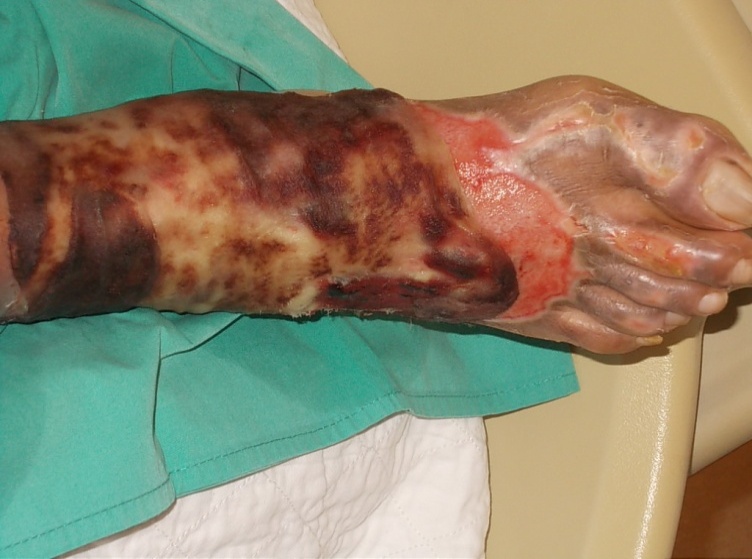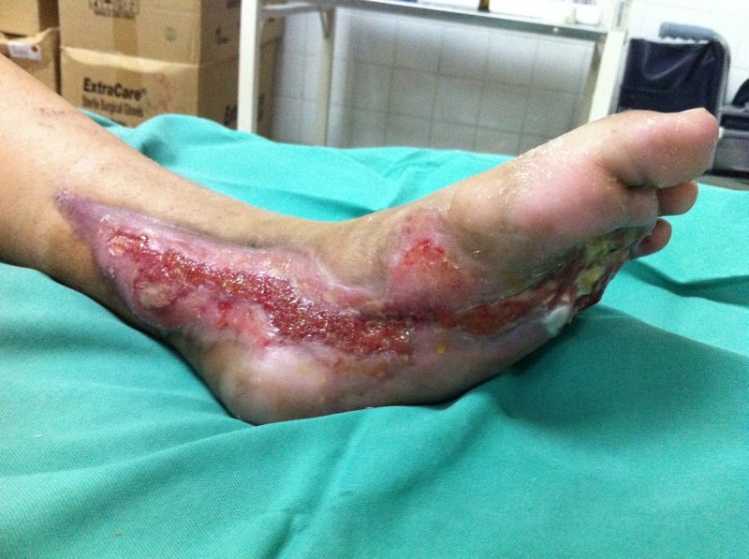Self-induced burn injury from thermal footbath in patients with diabetes neuropathy—a common mishap in Asian culture
Huai Heng Loh and Florence Tan
Cite this article as: BJMP 2014;7(1):a702
|
|
Abstract We report three cases of diabetic patients with peripheral neuropathy who sustained severe burn injuries to the foot due to use of thermal footbath with the intention to “improve circulation” and “relieve numbness”. Use of thermal footbath is common among Asian diabetic patients with peripheral neuropathy. This has resulted in accidental burn injuries. Due to high susceptibility to secondary infection, delayed presentation further complicates and prolongs hospital stay. There is a need for greater public awareness. Education regarding avoidance and consequences of this highly preventable injury should be incorporated into standard diabetic foot care education in clinical practice. Keywords: Thermal footbath, severe burn injuries, diabetic neuropathy |
Introduction
Diabetic patients with peripheral neuropathy are predisposed to foot injury. In Asian countries, a common culture among patients with peripheral neuropathy is to immerse their feet in hot water baths, with a belief that it will “improve circulation” and hence “cure the numbness”. We hereby report three cases of severe burn injuries of the feet presented to our hospital over a span of six months due to the above belief.
Case Report
The first patient was a 53-year old Malay gentleman with poorly controlled diabetes mellitus for six years, complicated with peripheral neuropathy, diabetic nephropathy and right eye cataract (latest HbA1C 8.1%), treated with oral anti-diabetic agents. He had a habit of using hot footbaths for numbness of both feet. Two weeks prior to presentation, due to increased feeling of numbness, he immersed his right foot into a self-prepared tub of hot water with added salt, followed by application of traditional sea cucumber gel. That evening, he noticed blistering of his right foot. Despite advice for admission, he chose to do the dressing as an outpatient in a local clinic. He presented two weeks later due to a worsening wound. At presentation, 4% full thickness burn of his right foot was noted, complicated by secondary infection (Figure 1). He underwent wound debridement, and subsequent split skin grafting. He had a prolonged hospitalization of five weeks due to secondary pseudomonas wound infection requiring parenteral antibiotics.
Figure 1. Right lower limb upon presentation to our hospital
The second patient was a 26-year old Indian gentleman with type I diabetes mellitus for nine years, complicated with diabetic nephropathy and peripheral neuropathy. His wife usually prepared hot water footbaths for him to improve his feet circulation. He developed 5% full thickness burn when he immersed his right foot into a pail of boiling water, not knowing that his wife had not added cold water into the footbath. He presented himself after two days and was hospitalized for two weeks. He recovered after wound debridement and split skin grafting.
The third patient was a 17-year old Chinese lady with poorly controlled type I diabetes mellitus for eight years, complicated with diabetic nephropathy (latest HbA1C 10.0%). She used hot water steam therapy with an aim to cure her recent onset of left foot drop, but was unaware of the temperature of the water. She developed blisters on her left foot, but only presented herself two weeks later when she developed left foot gas gangrene. She had a prolonged hospital stay of eight weeks with recurrent hospital acquired infections, including Methicillin-resistant Staphylcoccus aureus (MRSA). Despite multiple wound debridement, she required amputation of her left fifth toe (Figure 2).
Figure 2. Left lower limb post Ray amputation
Discussion
Peripheral neuropathy is a known complication of diabetes mellitus. More than 50% of patients who are over 60 years old have this complication.1, 2 Thermal injury to the feet in patients with neuropathy has been reported after walking barefoot on hot surfaces3 and after application of hot water bottles or heating pads during winter months.4, 5 The use of thermal footbath as a cause of burn injury is mostly due to patient-misuse or ignorance of correct usage.6, 7 In contrast, in Asian countries, a common culture among patients with peripheral neuropathy is to immerse their feet in self-prepared hot water without checking the water temperature,8 with a belief that it will “improve circulation” and hence “cure the numbness”. This practice has led to accidental burn injuries as described in our case reports.
There are a few reasons why patients with diabetic peripheral neuropathy end up with such a severe complication after the use of thermal footbath. Firstly, the temperature of the thermal bath may be underestimated. The time to develop full thickness burn reduces exponentially with just minimal increments in water temperature.9 Secondly, lack of pain despite the burn can prolong exposure to the heat source. In addition, concomitant peripheral vascular disease and endothelial function can limit vasodilatation to conduct heat away hence further aggravate the thermal insult.
Another important contributing factor of complicated wounds are the delays in seeking treatment as the result of lack of pain despite the burn injury. In a study done by Memmel et al on 1794 patients (of which 130 were diabetics) who presented with burn injuries, the majority of non-diabetic burn patients (63%) presented within 48 hours of injury, but only 40% of diabetic patients sought treatment within that time frame. Significantly more patients with diabetes presented after two weeks compared to those without diabetes. As burn injuries are highly susceptible to secondary infection, any delay in presentation further complicates and prolongs hospital stay.10,11 Not surprisingly, our two patients who presented two weeks after their burn injury had a prolonged and complicated hospital course compared to our second patient who presented soon after the burn injury. Increased susceptibility to infection and delayed wound healing from poor circulation contribute to prolonged recovery and poorer clinical outcomes in patients with diabetes mellitus, with some needing amputation as noted in our third patient.
As a healthcare provider we play a role in preventing this misfortune. Routine screening for the presence of peripheral neuropathy and vascular disease should be done during clinic visits to identify high-risk patients. Specific education regarding avoidance of thermal footbath and consequences of this highly preventable injury should be incorporated into standard diabetic foot care education. If patients choose to immerse their feet in hot water, temperature of the water should always be measured with a thermometer and immersion time should be limited. If a wound develops, they should present early to hospital for immediate treatment.
Conclusion
Thermal footbath for therapeutic purposes is commonly practiced in Asian culture. Our case reports highlight the serious consequences of this practice in diabetic patients with peripheral neuropathy. More public awareness and patient education is needed to prevent these injuries and to avoid the high cost of prolonged hospital stay and losses to the patient.
|
Competing Interests None declared Author Details HUAI HENG LOH, MRCP (UK), University Malaysia Sarawak, Kuching, Malaysia. FLORENCE TAN, MRCP (UK), Sarawak General Hospital, Kuching, Malaysia. CORRESPONDENCE: HUAI HENG LOH, University Malaysia Sarawak, Faculty of Medicine and Health Sciences, Lot 77 Section 22, KTLD Jalan Tun Ahmad Zaidi Adruce, 93150 Kuching Sarawak, Malaysia. Email: luohuaixin@gmail.com |
References
1. Young MJ, Boulton JM, Macleod AF, et al. A multicentre study of the prevalence of diabetic peripheral neuropathy in the United Kingdom hospital clinic population. Diabetologia 1993; 36: 150-154
2. Mimi O, Teng CL, Chia YC. The prevalence of diabetic peripheral neuropathy in an outpatient setting. Med J Malaysia 2003; 58: 533-538
3. Gaztelu V, Gago Fornells M, Garcia Gonzales RF, et al. Hot sand burns on the sole of a patient with diabetes. J Wound Care 2002; 11: 170-171
4. Katcher ML, Shapiro MM. Lower extremity burns related to sensory loss in diabetes mellitus. J Fam Pract 1987; 24: 149-151
5. Jose RM, Vidyadharan R, Roy DK, et al. Hot water bottles and diabetic patients – a cautionary tale. Br J Gen Pract 2005; 55: 222-223
6. Dijkstra S, vd Bent MJ, vd Brand HJ, et al. Diabetic patients with foot burns. Diabetic Medicine 1997; 14: 1080-1083
7. Balakrishnan C, Rak TP, Meininger MS. Burns of the neuropathic foot following use of therapeutic footbaths. Burns 1995; 8: 622-623
8. Thng P, Lim RMC, Low BY. Thermal Burns in Diabetic Feet. Singapore Med J1999; 40(05): 362-364
9. Accurate Building Inspectors. New York: Ubell Enterprises, Inc; c2003-2013 [cited 2012 June 12] Hot Water Burn & Consumer Safety. Available from: www.accuratebuilding.com
10. Zachary LS, Heggers JP, Robson MC, et al. Burns of the feet. J Burn Care Rehabil1987; 8: 192-194
11. Memmel H, Kowal-Vern A, Latenser BA. Infection in Diabetic Burn Patients. Diabetes Care 2004; 27(1): 229-233

The above article is licensed under a Creative Commons Attribution-NonCommercial-NoDerivatives 4.0 International License.




